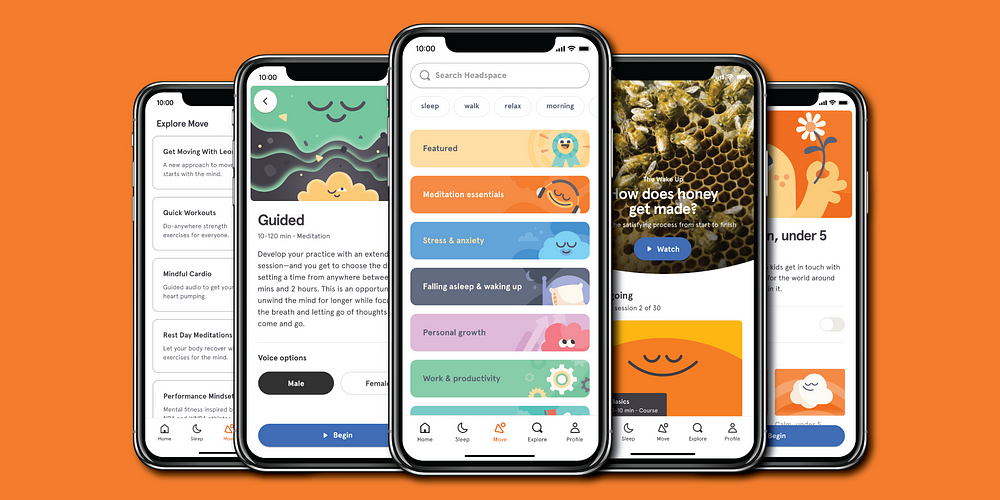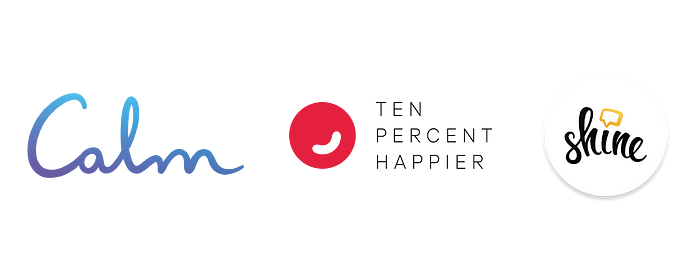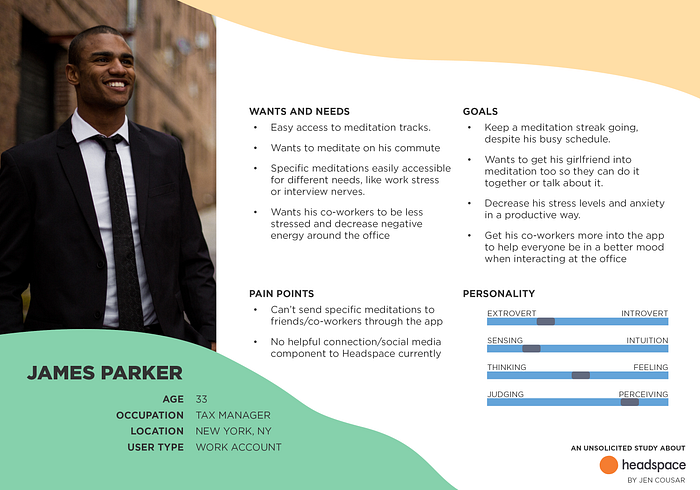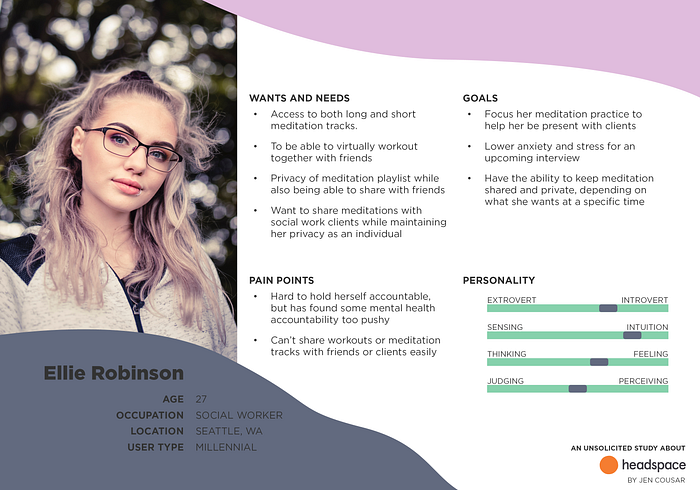Getting a little Headspace — a UX case study

Take a deep breath. It’s a phrase that has been used in every situation from dissolving tension in a heated meeting to helping a friend calm down in a panicked moment. This phrase, and the methodology of breathing, meditation, and mindfulness have taken hold of society. And that’s where Headspace comes in.
The Challenge
The initial challenge for this project was to identify a digital experience and embark on a deep dive into the product’s users and what they may be lacking in their current user experience. I chose to explore Headspace, the popular and highly successful meditation and mindfulness app.
Founded in 2010 by Andy Puddicombe and Richard Pierson, Headspace was their attempt to help people find their inner zen and be able to learn meditation in a simple, sustainable way. Puddicombe, a former Buddist monk, wanted to “to make meditation accessible, relevant and beneficial to as many people as possible.” Puddicombe and Pierson met at a meditation clinic and the rest, as the saying goes, is history.
You Have to Start Somewhere
Creating a Research Plan
After choosing Headspace as my focus product, I began by making a research plan. Since I am still a newbie when it comes to UX research, I did some digging and found a Medium article by Margie Mateo Villanueva that I based my plan’s layout on.
The research plan was divided into three phases of study: foundational research, user and discovery research, and evaluative research. This covered the gamut from initial discovery of the product and it’s users to compiling a competitive analysis, preparing for and conducting user interviews, creating personas, and finally synthesizing that research into findings and next steps.

Checking Out the Competition
A key component of the research process was conducting a competitive analysis and SWOT (strengths, weaknesses, opportunities, threats) matrix. This allowed me to develop ideas about what Headspace might be missing from it’s user experience as well as confirm unique opportunities against what their competitors are already doing.

Of the three main competitors that I analyzed, there were commonalities as well as widely different value propositions that made each one stand out in the market. All three offer a meditation and mindfulness component, however their approaches and target audiences are different.
- Calm is the most direct competitor to Headspace, with it’s focus being on traditional meditation and mindfulness, and using similar features like meditation streaks, total minutes meditated, and specified topic meditations like stress and anxiety.
- Ten Percent Happier also offers guided meditation, but has a wider reach — it started as a book by Dan Harris and has evolved to the app as well as a podcast — and speaks to the skeptics of the world who can’t sit still and think meditation isn’t worthwhile (until they try Ten Percent Happier, apparently).
- Shine’s focus is providing accessible mental health resources to a diverse audience, and doing so in a way that makes it easy and helpful for beginners who may have never looked into meditation. Shine is also one of the only competitor platforms to incorporate a community feature where users can share quotes and reflect on prompts together.
It’s All About the Users, Baby
In addition to desk research, I knew I had to find out what the most important people — the Headspace users — thought about the app. By this point, I was interested in a specific feature of the app where users can “nudge” their buddies on the app to give them words of encouragement or a reminder to meditate. I knew I wanted to incorporate questions about this feature into my user interviews.
Finding & Screening Users
According to their website, Headspace currently has millions of users that reside in more than 190 countries, so finding users to interview felt like a relatively simple task. Since I don’t speak any other languages and don’t have easy access to a translator, I kept my search local and only interviewed users that currently reside in the United States.
I utilized a screener to ensure the users that I chose to interview would meet the following criteria:
- they have used the Headspace app before
- they are at least a moderate user in terms of time on the app
- they are either a millennial or have a membership paid for by their place of work (I chose to focus on these two primary user groups)

User Interviews & Findings
I started the interviews with a few general questions, and found that all participants felt the Headspace app is easy and pleasant to use, and has visually striking design elements. Each user found themselves interested in meditation for different reasons, and similarly most had different reasons for using the app and different features they liked most.
“I like the design of the app and think it’s pretty user friendly. And I love the voice of the Australian man who leads some of the meditations.” — User 3
“I like that they have topic-based things and not just general stuff…I mostly use the burnout ones and the stress and pain ones as well.” — User 1
Feature-Specific Questions about ‘Buddies’
In each interview, after collecting general thoughts and uses, I narrowed my questioning to ask more about the social/buddy features of the app to see how users felt and what their current usage was for this feature.

Most users had never noticed this feature, and were initially skeptical...
“I guess my gut feels like it’s unnecessary…I just don’t see that as a motivator for me. If anything I think it has the potential to be kind of annoying.” — User 1
“It almost feels gimmicky, in an app that I actually find otherwise very function oriented. That feels strange and off-brand.” — User 6
…BUT, they didn’t hate the idea completely.
Overall the users felt like the current state of the Buddy feature wasn’t something they’d use as is, but four of the six expressed they’d be interested in using it differently. They mentioned:
- Some mentioned being able to send recommendations of courses to others (User 1)
- Others thought it would be cool to be able to do the workouts in the app with a friend (User 5)
- Or even friend challenges or being able to comment on completed meditations (User 3)
The Ah-Ha Moment
After compiling all of the research data from the user interviews and initial research, I realized that the Buddy connection feature was the area that Headspace needed the most help with, and that simultaneously it was a niche enough concept in the meditation app realm that it could offer added value to the product.
Who Is this Even For?
After collecting all the data, the next step was to compile the research and create a persona for each of my user types — millennial users and company membership users.
Personas
Each person was created with the goal of improving the social/buddy feature, while also considering the previous research and data from the interviews I’d conducted. My personas, Ellie and James, existed to help me through the rest of the process.


“Every great design begins with an even better story.”
— Lorinda Mamo, Designer / Creative Director
User Stories
With personas in hand, I was next charged with beginning to create user epics and user stories. This was not something I’d ever done before, and I was excited to try my hand at writing them. Here are a few of the user stories I created:
EPIC: As a millennial user, I want to send and recommend meditations to my friends and family so that I can help them through challenging times and share meditations that I enjoy with them.
Acceptance Criteria: Given I am logged into my account, when I share meditations with family and friends, then they will receive them and know that I sent them.
— —
User Story: As a millennial user, I want to have a “share” button connected with each meditation so that I can easily send the meditation to family or friends.
Acceptance Criteria: Given I am a user and logged in to my account, when I view a meditation I can click the share button and then choose who I want to send it to.
Notes: Will it be feasible for the user to share a meditation with someone who does not have a Headspace account?
— —
User Story: As a millennial user, I want to have options to share in-app or via email or other avenues so that I can share meditations with friends and family who need them, even if they don’t subscribe to Headspace.
Acceptance Criteria: Given I am a user and logged into my account, when I select the “share” button in Headspace, I am given the option to send in the app, or via email or text message, and then I can send the meditation to the person I want to.
Notes: Again, this would be contingent on whether or not it is feasible/realistic to allow users to send specific meditations to non-users of the app. Would need to determine how this could/would work.

So Now What?
For the purposes of this project — which is for my Masters in UX Design at MICA — we were asked to take a deep dive into studying users and conducting research, so as of this moment this is where my journey with Headspace ends.
That being said, I’m a massive design nerd and likely won’t be able to keep myself from taking it further. With that in mind, I’ll share what I anticipate my next steps will be and where I’d like to take the buddy feature from here.
More Stories
Wireframing will be the next major step, but prior to that I will need to write more user stories. These will serve as the template for things that I’ll need to add and processes I’ll work through to create a full experience for the buddy feature.
Wireframe
I’ll create medium fidelity wireframes for how the buddy feature (including sharing, a calendar, and possibly community discussions) would work and integrate into the existing Headspace app. Creating these features will toe a thin line between desired connection and need for privacy, so I will need to come up with multiple ideas and think through all the ways that this feature should and should not exist in the meditation app space.
Prototype, Test & Make It Better
Once the wireframes are together, I’ll make them interactive and create user testing protocols. I will likely as my original users who were kind enough to be interviewed, as well as others. I will set up my testing in a task-oriented way at first, and then offer the option for the users to give open-ended feedback about the overall experience and their thoughts on the feature itself.
Thanks for checking out my user case study on Headspace. If you have any feedback I’d love to hear it, so leave something in the comments! Additionally, I am not affiliated with the Headspace company in any way, I’m just a nerdy and curious designer working on developing her skills.

